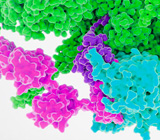-
REAGENT SERVICES
Hot!
-
Most Popular Services
-
Molecular Biology
-
Recombinant Antibody/Protein
-
Reagent Antibody
-
CRISPR Gene Editing
-
DNA Mutant Library
-
IVT RNA and LNP Formulations
-
Oligo Synthesis
-
Peptides
-
Cell Engineering
-
- CRISPR/Cas9 sgRNA
- CRISPR/Cas12a crRNA
- Prime Editing Guide RNA
- Base Editing Guide RNA
- HDR Templates
- gRNA + HDR Template Design Tools
- cGMP Guide RNA
- cGMP HDR Templates
- CRISPR/Cas Proteins
- CAR-T Knock-in Optimization Kit
- CRISPR Plasmids
- CRISPR gRNA Plasmid Libraries
- CRISPR Cell Lines
- Microbial Genome Editing
-
-
PRODUCTS
-
Most Popular Reagents
-
 Instruments
Instruments
-
Antibodies
-
ELISA Kits
-
Protein Electrophoresis and Blotting
-
Protein and Antibody Purification
-
Recombinant Proteins
-
Molecular Biology
-
Stable Cell Lines
-
Cell Isolation and Activation
-
 IVD Raw Materials
IVD Raw Materials
-
 Therapy Applications
Therapy Applications
-
Resources
-
- Pharmacokinetics and Immunogenecity ELISA Kits
- Viral Titration QC ELISA Kits
- -- Lentivirus Titer p24 ELISA KitHot!
- -- MuLV Titer p30 ELISA KitNew!
- -- AAV2 and AAVX Titer Capsid ELISA Kits
- Impurity Test ELISA Kits
- -- BSA ELISA Kit, 2G
- -- Cas9 ELISA KitNew!
- -- Protein A ELISA KitNew!
- -- His tagged protein detection & purification
- -- dsRNA ELISA Kit
- -- Endonuclease ELISA Kit
- COVID-19 Detection cPass™ Technology Kits
-
- Automated Maxi-Plasmid PurificationHot!
- Automated Mini-Plasmid PurificationNew!
- PCR Reagents
- S.marcescens Nuclease Benz-Neburase™
- DNA Assembly GenBuilder™
- Cas9 / Cas12a / Cas13a Nucleases
- Base and Prime Editing Nucleases
- GMP Cas9 Nucleases
- CRISPR sgRNA Synthesis
- HDR Knock-in Template
- CRISPR Gene Editing Kits and Antibodies
-
![AmMag™ Quatro Automated Plasmid Purification]() AmMag™ Quatro automated plasmid purification
AmMag™ Quatro automated plasmid purification
-
![Anti-Camelid VHH]() MonoRab™ Anti-VHH Antibodies
MonoRab™ Anti-VHH Antibodies
-
![ELISA Kits]() ELISA Kits
ELISA Kits
-
![Precast Gels]() SurePAGE™ Precast Gels
SurePAGE™ Precast Gels
-
![Quatro ProAb Automated Protein and Antibody Purification System]() AmMag™ Quatro ProAb Automated Protein and Antibody Purification System
AmMag™ Quatro ProAb Automated Protein and Antibody Purification System
-
![Target Proteins]() Target Proteins
Target Proteins
-
![AmMag™ Quatro Automated Plasmid Purification]() AmMag™ Quatro automated plasmid purification
AmMag™ Quatro automated plasmid purification
-
![Stable Cell Lines]() Stable Cell Lines
Stable Cell Lines
-
![Cell Isolation and Activation]() Cell Isolation and Activation
Cell Isolation and Activation
-
 IVD Raw Materials
IVD Raw Materials
-
![Quick
Order]() Quick Order
Quick Order
-
![Quick
Order]() Quick Order
Quick Order
- APPLICATIONS
- RESOURCES
- ABOUT US
- SIGN IN My Account SIGN OUT
- REGISTER

![Amino Acid Code Amino Acid Code]()
Biology Terms Dictionary
This Biology terms dictionary provides query services for biology and biochemistry terms. Please enter the biology or biochemistry terms you want to search.
List by Alphabet: A B C D E F G H I J K L M N O P Q R S T U V W X Y Z
Cell-Free Protein Expression
Introduction
Cell-free protein expression is a versatile and rapid method for synthesizing proteins in vitro, bypassing the need for live cells. This technique employs a reaction mixture containing cell lysates or purified transcription and translation machinery, along with essential substrates such as necessary nucleotides, amino acids, and energy sources. It offers significant advantages in speed, scalability, and the capability to produce toxic or complex proteins that might otherwise be challenging to express in living systems.
Mechanisms of Cell-Free Protein Expression
-
Source of Cell-Free Extracts
The foundation of the cell-free system lies in lysates prepared from organisms such as Escherichia coli, wheat germ, rabbit reticulocytes, or insect cells. These extracts provide the necessary transcriptional and translational components.
- E. coli-based systems are commonly used for their robustness and high yield.
- Eukaryotic systems (e.g., rabbit reticulocytes) are preferred for complex post-translational modifications.
-
Preparation of the Reaction Mixture
- DNA or mRNA templates encoding the protein of interest.
- Energy regeneration systems (e.g., ATP, GTP) for sustained protein synthesis.
- Buffer components to stabilize enzymes and substrates.
-
Transcription and Translation
In coupled transcription-translation systems, DNA templates are transcribed into mRNA in the same reaction vessel, streamlining the process. Ribosomes in the lysates translate the mRNA into proteins, supported by tRNAs, elongation factors, and other translation machinery.
-
Optimization and Yield Enhancement
Reaction parameters such as magnesium ion concentration, temperature, and template concentration are optimized for maximum yield. Incorporation of chaperones aids in proper protein folding, and additives like detergents can enhance solubility.
-
Protein Purification and Functional Assessment
After synthesis, proteins are purified from the reaction mixture using affinity tags (e.g., His-tags). Functional assays are then conducted to ensure the bioactivity of the expressed proteins.
Applications
-
Research and Development
Cell-free systems are utilized for high-throughput screening of protein variants, functional studies, and protein engineering experiments.
-
Therapeutic Protein Production
This method enables the rapid synthesis of vaccines, cytokines, and monoclonal antibodies for therapeutic purposes.
-
Industrial Biotechnology
Enzymes for chemical synthesis, biofuel production, and pharmaceuticals are efficiently produced using cell-free systems.
-
Synthetic Biology and Diagnostics
Cell-free protein expression drives biosensors, synthetic circuits, and diagnostic tools by enabling precise protein synthesis under controlled conditions.
Advantages and Challenges
-
Advantages:
- Rapid synthesis without the need for cell growth.
- Ability to express toxic or aggregation-prone proteins.
- Simplified manipulation of reaction conditions for optimization.
-
Challenges:
- Limited scalability compared to cell-based systems.
- Dependency on costly reagents, such as energy substrates and cofactors.
- Difficulty in replicating complex post-translational modifications found in mammalian systems.
GenScript Services and Products
- Custom Protein Production: GenScript offers tailored cell-free protein expression services, ensuring high-quality protein production with rapid turnaround times.
- Template Optimization: With codon optimization and gene synthesis, GenScript enhances expression efficiency in cell-free systems.
- Protein Purification Solutions: Advanced purification techniques, such as affinity and size-exclusion chromatography, deliver highly pure and functional proteins.
Conclusion
Cell-free protein expression is a transformative approach to protein production, offering flexibility and speed unmatched by traditional, cell-based systems. Its applications in research, therapeutics, and industrial biotechnology have made it an indispensable tool in modern molecular biology. Advances in system efficiency and cost reduction will further broaden its utility, reinforcing its role as a cornerstone technology in the future of protein synthesis.
- Tags:
- Protein
Related Biology Tools
-
GenSmart™ Codon Optimization
GenSmart Optimization is a free online tool for performing codon optimization to improve gene expression. GenScript's patented algorithms are integrated into the tool to optimize the computing capability of high-performance sequence generation.
-
DNA Construct Design Tool
GenSmart™ Design is a free online DNA construct design tool developed by GenScript. GenSmart™ Design has two design modules, the Create Construct module for individual plasmid design and the Create Library module for DNA library design.
-
Codon Frequency Tables
This online tool shows commonly used genetic codon frequency table in expression host organisms including Escherichia coli and other common host organisms.
Service and Products

Protein Expression
GenScript recombinant protein and rAb services provide high quality recombinant proteins and rAbs for a variety of downstream research applications.

Bacterial Expression
One-stop service from Sequence to Protein starting from $1600, 4 weeks.

Insect Expression
GenScript's BacuVance baculovirus expression system was developed by our in-house team of scientists for virus production and expression of recombinant proteins from baculovirus-infected insect cells.

Mammalian Transient Expression
Proprietary High Density (HD) expression system, enhance the protein yield up to 100 fold, achieve antibody titers up to 3 g/L.

Reagents for COVID-19 Research
Gram level, ready to ship RBD proteins, ACE2 assay cell lines and pseudovirus.
-
Top Search
-
Hot Glossary
-
Antibody
If you know of any terms that have been omitted from this glossary that you feel would be useful to include, please send detail to the Editorial Office at GenScript: website@genscript.com
If your term is adopted, we will send 1,000 EzCoupon points to your GenScript account.
-





































